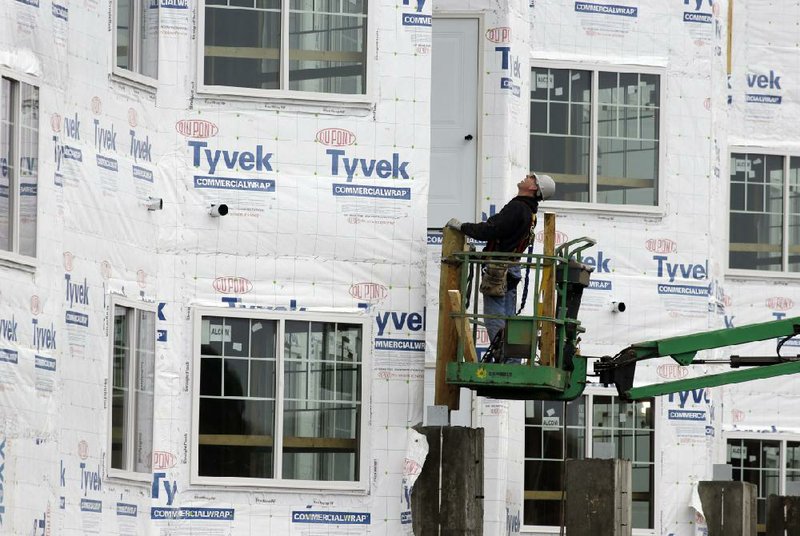WASHINGTON — U.S. home-builders began work at a slower pace in January than in December. But all of the drop occurred in the volatile area of apartment construction, which sank 24 percent. By contrast, the rate of single-family home-building rose 0.8 percent.
Even with the overall decline, the pace of home construction in January was the third-highest since 2008 and was evidence of continued strengthening in residential real estate, the Commerce Department said in a report released Wednesday.
“The fact that single-family starts are up is very encouraging, it is more important to the economy in terms of employment and growth” than the multifamily area, said Gus Faucher, a senior economist at PNC Financial Services Group Inc. in Pittsburgh. “The housing market recovery is continuing and will be an important contributor to economic growth. Permits look very solid, and that is a great sign.”
U.S. wholesale prices rose only slightly in January after three straight declines, the Labor Department said Wednesday in a separate report. The producer price index rose 0.2 percent last month, the first increase since September. Gasoline and other energy prices fell, while food prices jumped0.7 percent after dropping sharply in December.
In the past 12 months, wholesale prices have risen just 1.4 percent. That’s down from a 4.1 percent increase for the 12 months that ended in January 2012. Excluding the volatile food and energy categories, core prices rose 0.2 percent in January. They have risen a mild 1.8 percent over the past 12 months.
“Inflation should be con-tained in the near-term,” said Christophe Barraud, an economist at Market Securities-Kyte Group in Paris.
If prices were to begin rising rapidly, the Federal Reserve might be forced to raise rates to try to slow inflation.
Wholesale gas prices dropped 2.1 percent in January, the department said. Since then, pump prices have risen sharply. That is likely to push up inflation at the wholesale and consumer levels in coming months.
Applications for building permits, a signal of future construction, topped December’s rate, the Commerce Department report said. Applications for permits are at their highest point since mid-2008.
The Wednesday report said builders started work at a seasonally adjusted annual rate of 890,000 homes last month. That was down 8.5 percent from December, when housing starts had hit an annual rate of 973,000, the most since June 2008.
Analysts had expected a decline in January construction, given the gain in December. December had initially been reported at an annual rate of 920,000. On Wednesday, the department revised up the December pace to 973,000.
January’s was only the second drop in construction in the past six months. It still left the annual pace of homebuilding 23.6 percent higher than a year ago.
Economists noted thatbuilding permits keep increasing. Dan Greenhaus, chief global strategist for BTIG, said the increase in permits suggested that the January decline in construction starts would be temporary and that “as the year progresses, housing starts will continue to push higher.”
Greenhaus said he wouldn’t be surprised if construction starts topped 1 million for 2013.
The U.S. housing market is slowly regaining its health after stagnating for roughly five years after the housing boom collapsed. Steady job gains and near-record-low mortgage rates have encouraged more people to buy.
A steady rise in prices reflects, in part, fewer homes for sale. The supply of previously owned homes for sale has reached its lowest level in more than a decade. And the pace of foreclosures, while still rising in some states, has slowed on a national basis. That means fewer low-priced foreclosedon homes are being dumped on the market.
Those trends, and the likelihood of further price gains, have led builders to step up construction. Last year, builders broke ground on the most homes in four years.
For all of 2012, builders started work on 780,000 homes, about half the annual number consistent with healthy markets. But it represents a 28 percent jump from 2011. And it was the most housing startssince 2008, when construction was still falling after the housing bubble burst more than six years ago.
Sales of new homes jumped nearly 20 percent last year to367,000, the most since 2009. Still, many economists don’t foresee a full housing recovery before 2015 at the earliest.
Information for this article was contributed by Martin Crutsinger and Christopher S. Rugaber of The Associated Press; and by Shobhana Chandra and Alex Kowalski of Bloomberg News.
Business, Pages 23 on 02/21/2013
